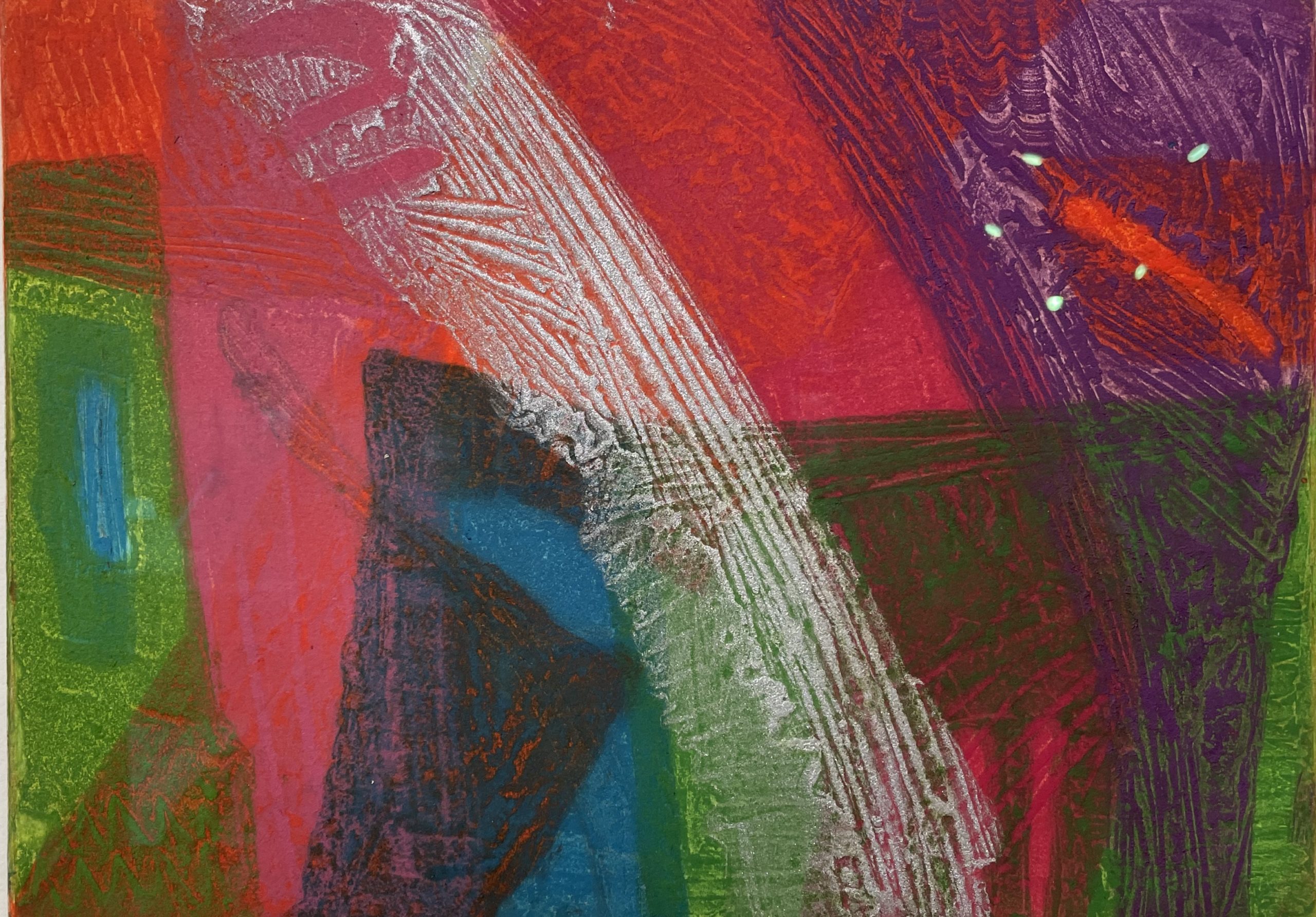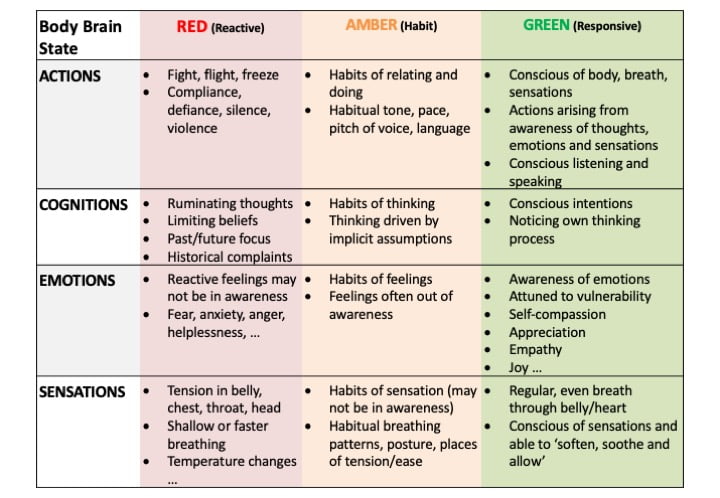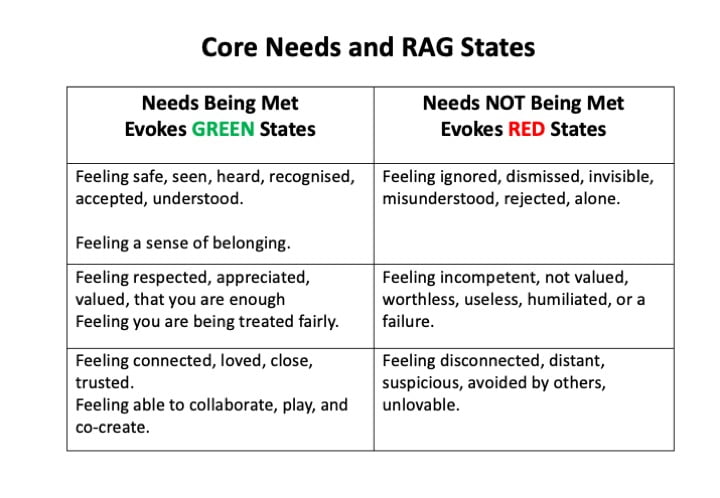The RAG Inquiry in Breakthrough Conversations Coaching

The RAG (Red, Amber, Green) Inquiry process I introduced in Breakthrough Conversations coaching is a method designed to enhance subjective awareness of embodied emotional states. It serves as a foundation for cultivating emotional regulation, expressive freedom and relational attunement. This article outlines what a RAG inquiry is, how to use it, and its links to attachment theory.
The Origins of the RAG Inquiry
The RAG inquiry emerged as an integration of three primary influences:
- the sustained, emergent, embodied inquiry used in Buddhist meditation
- the focused examining of key emotional moments through an understanding of core attachment needs
- the fostering of emotional regulation through relational attunement.
The idea of using a simple, traffic-light frame for exploring subjective emotional states developed from my use of mindfulness practices to support clients to inquire into the link between limiting or enabling patterns of Actions, Cognitions, Emotions, and Sensations. These four domains spell out ACES, and so I developed the ACES worksheet as a way of deconstructing experience. (I describe use of the ACES frame in the Breakthrough Conversations book.)
Clients gained great insight from these coach-guided explorations. But, despite my encouragement, they rarely used the ACES inquiry on their own, in the moment, to catch themselves when they were emotionally triggered.
So it was that I introduced the idea that our emotional states can be categorised into one of three types, Red, Amber, and Green states. This idea tallies with the distinctions we can find in neuroscience between triggered, habitual, and flow states, and the limbic system, the basal ganglia, and key areas of the prefrontal cortex. But I was not really aiming for scientific precision. Above all, I wanted the RAG frame to support subjective inquiry. I soon discovered that this apparently simple frame is deceptively powerful, because it is a doorway into much deeper inquiry. Indeed, used as a tool to support relational inquiry, it offers the potential for spacious self-observation, disidentification from emotions, expressive freedom, more skilful relating, and for some, an existential inquiry into meaning and purpose.
The RAG Framework Differentiates Three Emotional States
The RAG framework categorises emotional states into three distinct zones based on their intensity, reactivity, and impact on relational dynamics:
Red States: These represent moments of high emotional reactivity, such as anger, fear, or shame. Clients in a Red state may feel threatened, defensive, or overwhelmed. These are moments of emotional escalation where survival strategies are triggered, leading to limited flexibility in communication and behaviour.
Amber States: Amber represents habitual, automatic responses that occur ourside conscious awareness. These states are invaluable and effective in many routine situations, but they can become ineffective if applied unthinkingly to new circumstances or challenges.
Green States: Green states are characterized by calmness, openness, and flow. In this state, individuals feel safe, connected, and able to respond with emotional flexibility. These states allow for creativity, attunement, and authentic relational engagement.
Reading RAG through Body Sensations
We teach clients to recognise their RAG states by turning their attention to how emotions are expressing themselves through their experience of body sensations. If a client is describing a challenging situation that is causing frustration (a Red state), we invite them to bring the situation to mind, encouraging the experience of frustration to come fully alive in the mind’s eye. We then ask them to bring their attention down into the body, and to ask themselves what body sensations go with this emotion. We encourage them to name what they notice, using whatever adjectives, metaphors, or images most fully describe their subjective experience. Their ongoing reporting, aloud, of their experience, allows us to track their experience, to inhabit it with them as it were, to encourage them to stay with the sensations to see if they stay the same or change, and to be curious about new sensations and feelings that might emerge. We reflect back their experience and we might label it as a Red state. We emphasise that Red states are part and parcel of our human experience.. The great benefit of recognising our Red states is that it gives us a way of managing them more effectively.
We follow a similar process for evoking Amber and Green states. We look at routine situations to explore Amber states, or joyful and easeful situations to explore Green states. In examining all of these states, our goal is to support clients to come into a more curious and intimate relationship with their emerging, embodied emotions. The approach enables clients to observe and tolerate their emotional experiences without distracting themselves with habitual narratives or avoidant survival strategies. They also come to see that the patterns of body sensations evoked by RAG states are relatively predictable.
Sustaining Focus on Embodied Emotions
The initial emphasis in a RAG inquiry is to invite clients to examine their emotional states by noticing how emotions are expressing themselves through body sensations. In a similar way to Buddhist practices, this emphasis resists the tendency to shoe-horn experience into comfortable meaning-making, which forecloses the potential for emotional processing and new, emergent discoveries. The sustained focus supports clients to ‘surf the waves’ of their emotions, to tolerate them when they are unpleasant and to savour them when they are pleasant, and to witness how, if we just observe, they are in constant flux. Indeed, they discover that emotional blocks are often held in place by limiting narratives (cognitions), and that by staying with the embodied emotions, relatively free of sense-making, the blocks begin to dissolve and change all on their own.
Broadening the RAG Inquiry
Although the RAG inquiry resists a premature move into cognitive meaning-making or problem-solving, ultimately we support clients to explore how their processing of emotions impacts on their approach to specific, present-day challenges. Still using the Red, Amber, Green distinction, we support clients to explore the links between the four ACES domains of Actions, Cognitions, Emotions, and Sensations, as they relate to specific Red, Amber, and Green states. We might create a personalised version of the diagram below, so the client has an explicit summary of the typical ways they experience these states.
Deconstructing RAG States

When clients deconstruct their experience in this way, having already done some processing of the emotions that were driving their Red or ineffective Amber states, they more readily embrace the possibility of adopting a Green state and addressing their personal or relational challenges with more skill.
The RAG Inquiry is Underpinned by Attachment Theory
Breakthrough Conversations Coaching views attachment theory as offering insight into the core relational needs that drive much of human behaviour. Based on research with babies and infants through to studies with adults, we know that humans, in common with all mammals, need a secure base of relational safety to develop an interior sense of emotional resilience. With such a foundation we can express ourselves freely, be creative, form trusting relationships, and achieve our goals. But if our core needs are not met, then we resort to survival strategies that limit the flexibility of our expressive freedom. FIRO theory offers a helpful encapsulation of our core relational needs as a need for inclusion (e.g. to be seen and heard), control (e.g. to be appreciated and respected for our competence), and affection (e.g. to be liked and trusted ). Linking this to the RAG frame, Green states are evoked when our core needs are met, whereas Red states are evoked when our core needs are not met (see the diagram below).

The attachment frame offers helpful hypothesis about what might be driving certain behaviours. Clients often make such links themselves, because the RAG inquiry enables them to listen in to the longings that sit beneath their emotional states. Bringing an attachment perspective encourages curiosity about the origins of key survival strategies and supports clients to relate to their difficult emotions with self-compassion.
Simplicity leads to Personal Insight and Choice
The RAG inquiry offers a simple starting place for investigating subjective emotional states. By differentiating Red, Amber, and Green emotional states acording to the distinct bodily sensations that go with them, clients are more able to sustain an investigation into the everchanging, emergent nature of experience, and to discover that avoided emotions, when tolerated, become more manageable, and exert less influence over how they think and act. The RAG inquiry widens the window of emotional tolerance, and so opens up a space for wise reflection, insight, and more skilful behavioural choices.